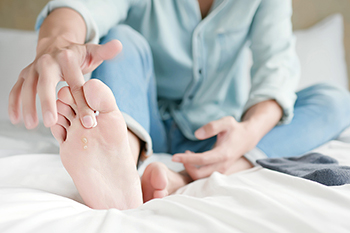Causes and Symptoms of Athlete’s Foot
Tuesday, 26 March 2024 00:00
Athlete's foot, also known as tinea pedis, is a common fungal infection of the foot caused by dermatophytes. This infection thrives in warm, moist environments and is often the result of coming into contact with contaminated surfaces, like locker room floors. Symptoms include scaling, peeling skin, and redness between the toes. Other symptoms of athlete’s foot are blistering and itching. If left untreated, athlete's foot can lead to secondary bacterial infections or allergic reactions, particularly in individuals with a compromised immune system or diabetes. Prevention involves maintaining good foot hygiene, wearing breathable footwear, and avoiding sharing personal items, like shoes or towels. If you suspect you have athlete's foot or experience severe symptoms like excessive redness, swelling, or pus, it's essential to seek prompt medical attention from a podiatrist. A podiatrist can provide an accurate diagnosis and recommend an advanced treatment plan to alleviate complications. For help in dealing with a stubborn athlete’s foot infection, It is suggested that you make an appointment with a podiatrist.
Athlete’s foot is an inconvenient condition that can be easily reduced with the proper treatment. If you have any concerns about your feet and ankles, contact Dawn Miles, DPM from Florida. Our doctor will treat your foot and ankle needs.
Athlete’s Foot: The Sole Story
Athlete's foot, also known as tinea pedis, can be an extremely contagious foot infection. It is commonly contracted in public changing areas and bathrooms, dormitory style living quarters, around locker rooms and public swimming pools, or anywhere your feet often come into contact with other people.
Solutions to Combat Athlete’s Foot
- Hydrate your feet by using lotion
- Exfoliate
- Buff off nails
- Use of anti-fungal products
- Examine your feet and visit your doctor if any suspicious blisters or cuts develop
Athlete’s foot can cause many irritating symptoms such as dry and flaking skin, itching, and redness. Some more severe symptoms can include bleeding and cracked skin, intense itching and burning, and even pain when walking. In the worst cases, Athlete’s foot can cause blistering as well. Speak to your podiatrist for a better understanding of the different causes of Athlete’s foot, as well as help in determining which treatment options are best for you.
If you have any questions please feel free to contact one of our offices located in Palatka and Saint Augustine, FL . We offer the newest diagnostic and treatment technologies for all your foot and ankle needs.









